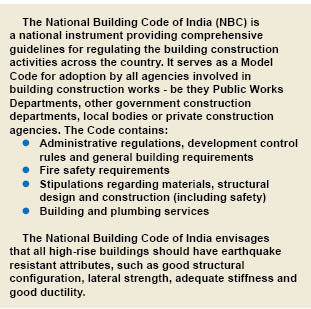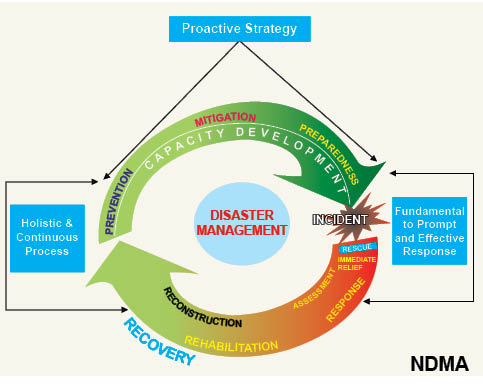
Gurgaonites are thinking afresh about their residence choices (and maybe even offices soon). In the wake of the earthquake in Nepal, which wreaked havoc with human life, property and the heritage of the erstwhile Himalayan Kingdom, many are now wondering if they should move into high-rise multi-storeyed buildings at all. This time the impact of the earthquake was felt quite distinctly, with tall buildings swaying disconcertingly. In fact the quake was clearly felt on ground floors too. The good fortune was that no high-rise was ‘impacted’ by the shocks. But for those tantalising seconds – in fact a minute plus this time, which truly felt like eternity – most people panicked, as they hurriedly descended the ‘unending’ flights of stairs. Malik, a resident of Sushant Lok Phase 1, says, “I had recently thought of buying a new flat in a DLF high-rise, but now I am worried. The earthquake and the consequent devastation have been really scary. Now I am very apprehensive of high-rises. Actually, honestly, I was never a fan of skyscrapers' I am ok with 'resonable' heights.” An official of the technical team of Homestead Infrastructure, a large building and construction company in Gurgaon, knowingly comments, "It is not earthquakes that kill, but the buildings. It depends on how resilient a building is on structural design. Building an earthquake-resistant structure has a lot to do with the foundation, which is designed according to the height and shape of the building. The entire NCR falls in the 'High Damage Risk Zone IV’. We incorporate best practices to ensure that we design and construct projects that can withstand quakes in this seismic zone. We have been strictly following the guidelines prepared by NDMA and National Building and Construction Code for the building of earthquake-resistant structures. In fact high-rises built using cutting-edge technology can withstand earthquakes much better than normal ‘quake-resistant’ buildings." Sumit Bharana, Director, Era Infrastructure, says, "Today we are building more high-rises than ever and these come with their own set of safety concerns - earthquakes being the biggest natural risk. The National Building Code of India (NBC) envisages that all high-rise buildings should have earthquake resistant attributes such as good structural configuration, lateral strength, adequate stiffness and good ductility. We have incorporated all the norms laid down by NBC and have been following the guidelines of NDMA (National Disaster Management Authority) as well. We go for the best possible engineering procedure to make the buildings earthquake resistant." Amarjit Bakshi, Managing Director, Central Park, says, “Our buildings have earthquake-resistant designs and we follow all mandatory norms that are applicable to NCR Seismic Zone 4. The design takes into consideration all parameters from a structural safety point of view. The structure is adequately strengthened through the use of sheer walls, to cater to ‘movements’ during an earthquake. This apart, the structure is also vetted by third party structural consultants, to ensure that all safety norms are taken care of." While an earthquake is a natural disaster that cannot be predicted, there are preventive measures that can be adopted. Jayshree Ghosh, an architect, says, “Every State in India has its own (building) code. The potentially earthquake prone areas necessitate a more stringent code and stronger building bye-laws, which are to be followed for the construction of buildings. Architects have to follow the National Building Code and Neufert – Architects’ Data (an architectural standard). For instance, hilly areas have a different testing pattern and code.”

Dr. Abhay Shrivastava, Head of Disaster Management, HIPA (Haryana), says, "We have everything, but are we really prepared for any sudden crisis? This is a tough question to answer. Yes, our Government is working on measures to improve Disaster Management techniques, but we need to be much more aware and active. We have already worked on a project called ‘Capacity Building in District Management’ for nine districts. We are now working on another 12 districts.” Dr. Shrivastava says that India is today much better placed to tackle post-quake issues. He adds that the country has enough resources, but there is a need to prioritise. “Hospitals and the police force are the two most worked entities during any crisis impacting human life. But the infrastructure currently available may not be adequate to handle a sudden natural crisis of the nature that we have just witnessed (in Nepal). Our system should better comprehend the different facets of such a crisis, to ensure that we can be of best help to the masses,” he says. He is cautious about ‘retrofitting’. The buildings, according to him, should have stringent bye-laws and accountability around aspects such as soil testing. “Nowadays there are many high-rises and it is tough to comment on those buildings. If these collapse due to an earthquake, and subsequent investigation finds inadequacies in the safety norms followed, it will land many of the builders in deep trouble,” he says. Though vital equipment like gas cutter, victim location machine and thermal image camera – which are necessary for tackling any disaster - are not available with the department concerned, DRO Ajit Singh is not unduly alarmed. ”We are ready for any disaster. There are enough resources. Our police force is well prepared and so are the hospitals and the blood banks. We also conduct mock drills once or twice a month. There is no reason to panic. Anyway, a natural disaster will not knock before it comes. If anything happens, we just have to act ‘as required’. While a natural disaster can strike at will, our preparedness and the ability to deal with a crisis is most important,” he says. According to TLC Satya Prakash, DC, Gurgaon, Nature’s natural balance should not be disturbed. Referring to the Aravali forest area, he says that it has played a very significant role in ensuring an ecological balance. However, he admits that the benefit of this in terms of, say, helping reduce the impact of a natural disaster, is difficult to assess. For instance, Nepal, he says, was more eco-friendly in terms of forest cover, and yet it was mutilated by the recent earthquake. “According to me it is the geological conditions that dictate the kind of risk an area can have and how much it will be impacted by a natural disaster,” he says. The low groundwater situation in Gurgaon may be a more pertinent issue, as it should have a direct impact on the level of ‘shock’ from underground. Higher density of water at all levels, including just below the (land’s) surface, should be able to lessen an earthquake’s impact. Would low groundwater therefore be a double-whammy for this Millennium City?
The citizens of Gurgaon are clearly worried about the impact of such a disaster and find little comfort in the City’s ‘preparedness’. Alarms have been raised and people have been cautioned that more such shocks could be felt in the coming weeks. The City reportedly sits on 7 fault lines and can possibly be hit by a 7.5 (Richter) scale earthquake. However, there are also the ‘realists’ like Shama Ali, who resides near Galleria Market. She says, “I came here from Kashmir fifteen years ago, for a better life. Now where do I go? What is safe? Where is it really safe? Can I run away from such a disaster, if it were to strike? How much can I do? I cannot now leave my house and run away. I believe that the best answer is to prepare well for such disasters.” It is important that people are made aware of their nearest evacuation sites - such as low-rise schools and parks; have access to emergency food and water supplies; pre-determine how to contact family members and friends or gather together after a disaster. Identity cards, phone numbers, addresses as well as information on blood type should be carried on one’s person. Everyone should have the contacts of important government institutions and other private groups that can help in an evacuation process or provide immediate relief. Finally, it is always best to test. We must continue to regularly carry out community drills – in residential, commercial, industrial and institutional areas. We must conduct safety audits of current buildings and high-rises, and now strictly ensure that they are made as per laid down building codes before they are approved. The rest we can perhaps leave to Providence!

What we ignore, at our peril, is our responsibility to mitigate the possibility of serious damage to human life and property when such a natural calamity strikes. We just keep building…whatever and however and wherever. Nepal is a stark example of that, despite the country having been in an earthquake ‘anticipatory’ mood for years. Buildings of all types had just been allowed to mushroom everywhere. How quickly we forget that the 1988 Nepal earthquake, near the Indian border, had affected much of northern Bihar. It left cracks in 50,000 buildings, including the Raj Bhavan and the old secretariat building in Patna.
The low groundwater situation in Gurgaon (like in Bhuj) may be a more pertinent issue, as it should have a direct impact on the level of ‘shock’ from underground. Higher density of water at all levels, including just below the (land’s) surface, should be able to lessen an earthquake’s impact. Would the low level of groundwater therefore be a double-whammy for this Millennium City?
Read More...